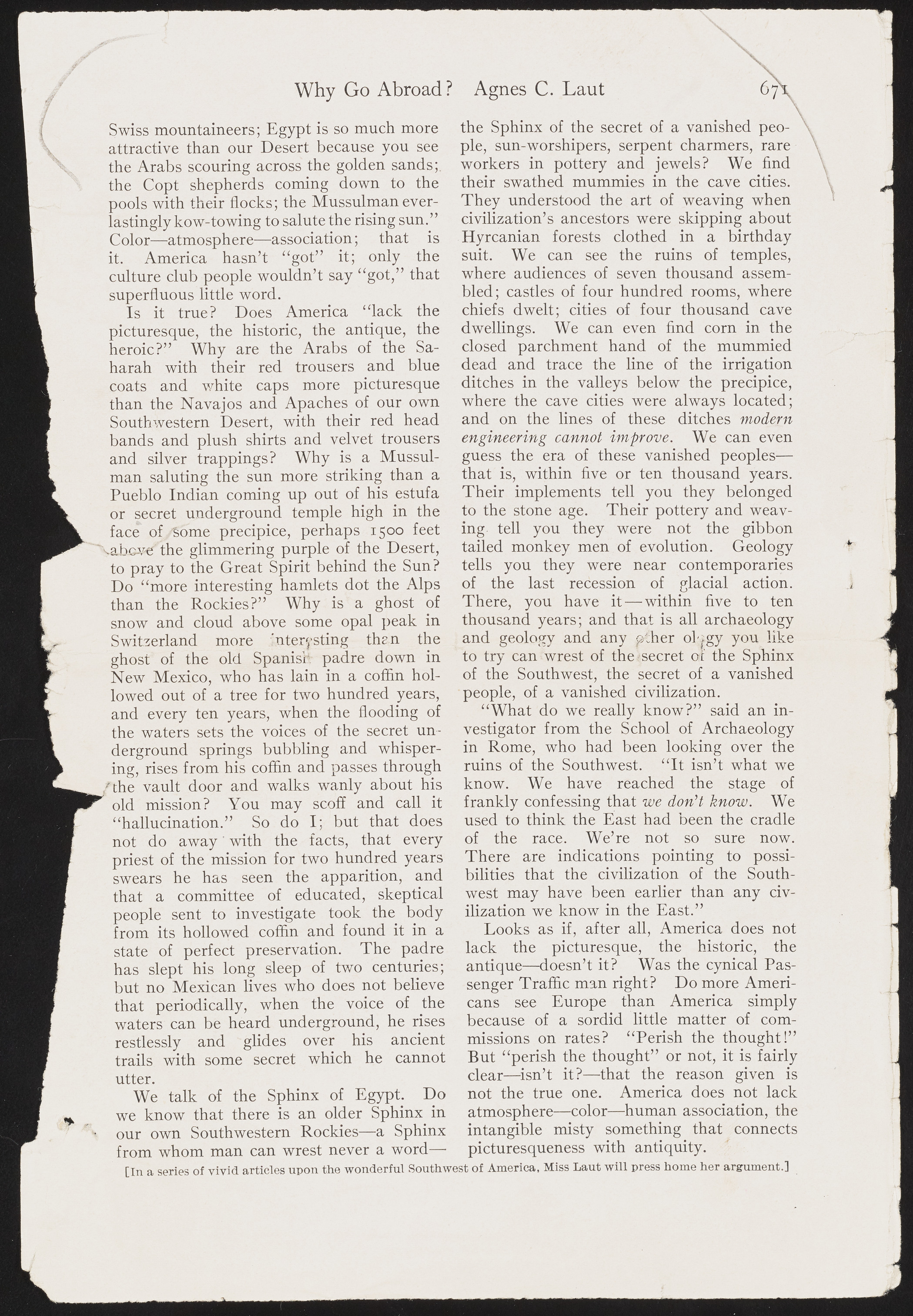Copyright & Fair-use Agreement
UNLV Special Collections provides copies of materials to facilitate private study, scholarship, or research. Material not in the public domain may be used according to fair use of copyrighted materials as defined by copyright law. Please cite us.
Please note that UNLV may not own the copyright to these materials and cannot provide permission to publish or distribute materials when UNLV is not the copyright holder. The user is solely responsible for determining the copyright status of materials and obtaining permission to use material from the copyright holder and for determining whether any permissions relating to any other rights are necessary for the intended use, and for obtaining all required permissions beyond that allowed by fair use.
Read more about our reproduction and use policy.
I agree.Information
Digital ID
Permalink
Details
Member of
More Info
Rights
Digital Provenance
Publisher
Transcription
Why Go Abroad ? Swiss mountaineers; Egypt is so much more attractive than our Desert because you see the Arabs scouring across the golden sands;, the Copt shepherds coming down to the pools with their flocks; the Mussulman everlastingly kow-towing to salute the rising sun.” Color— atmosphere— association; that is it. America hasn’t “ got” it; only the culture club people wouldn’t say “ got,” that superfluous little word. Is it true? Does America “ lack the picturesque, the historic, the antique, the heroic?” Why are the Arabs of the Sa-harah with their red trousers and blue coats and white caps more picturesque than the Navajos and Apaches of our own Southwestern Desert, with their red head bands and plush shirts and velvet trousers and silver trappings? Why is a Mussulman saluting the sun more striking than a Pueblo Indian coming up out of his estufa or secret underground temple high in the face of /Some precipice, perhaps 1500 feet vaboV'd the glimmering purple of the Desert, to pray to the Great Spirit behind the Sun? Do “ more interesting hamlets dot the Alps than the Rockies?” Why is a ghost of snow and cloud above some opal peak in Switzerland more interesting then the ghost of the old Spanish padre down in New Mexico, who has lain in a coflin hollowed out of a tree for two hundred years, and every ten years, when the flooding of the waters sets the voices of the secret underground springs bubbling and whispering, rises from his coflin and passes through /the vault door and walks wanly about his old mission? You may scoff and call it “ hallucination.” So do I; but that does not do away ’ with the facts, that every priest of the mission for two hundred years swears he has seen the apparition, and that a committee of educated, skeptical people sent to investigate took the body from its hollowed coffin and found it in a state of perfect preservation. The padre has slept his long sleep of two centuries; but no Mexican lives who does not believe that periodically, when the voice of the waters can be heard underground, he rises restlessly and glides over his ancient trails with some secret which he cannot utter. We talk of the Sphinx of Egypt. Do we know that there is an older Sphinx in our own Southwestern Rockies— a Sphinx from whom man can wrest never a word— [In a series of vivid articles upon the wonderful Southw Agnes C. Laut 67\ the Sphinx of the secret of a vanished people, sun-worshipers, serpent charmers, rare workers in pottery and jewels? We find their swathed mummies in the cave cities. They understood the art of weaving when civilization’s ancestors were skipping about Hyrcanian forests clothed in a birthday suit. We can see the ruins of temples, where audiences of seven thousand assembled; castles of four hundred rooms, where chiefs dwelt; cities of four thousand cave dwellings. We can even find corn in the closed parchment hand of the mummied dead and trace the line of the irrigation ditches in the valleys below the precipice, where the cave cities were always located; and on the lines of these ditches modern engineering cannot improve. We can even guess the era of these vanished peoples— that is, within five or ten thousand years. Their implements tell you they belonged to the stone age. Their pottery and weaving tell you they were not the gibbon tailed monkey men of evolution. Geology tells you they were near contemporaries of the last recession of glacial action. There, you have it — within five to ten thousand years; and that is all archaeology and geology and any piher oRgy you like to try can wrest of the secret of the Sphinx of the Southwest, the secret of a vanished people, of a vanished civilization. “ What do we really know?” said an investigator from the School of Archaeology in Rome, who had been looking over the ruins of the Southwest. “ It isn’t what we know. We have reached the stage of frankly confessing that we don’t know. We used to think the East had been the cradle of the race. We’re not so sure now. There are indications pointing to possibilities that the civilization of the Southwest may have been earlier than any civilization we know in the East.” Looks as if, after all, America does not lack the picturesque, the historic, the antique— doesn’t it? Was the cynical Passenger Traffic man right? Do more Americans see Europe than America simply because of a sordid little matter of commissions on rates? “ Perish the thought!” But “ perish the thought” or not, it is fairly clear—isn’t it?— that the reason given is not the true one. America does not lack atmosphere— color— human association, the intangible misty something that connects picturesqueness with antiquity. 3t of America, Miss Laut will press home her argument.]

